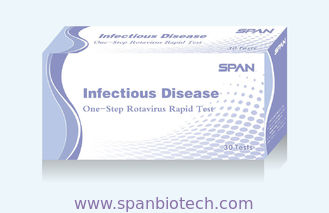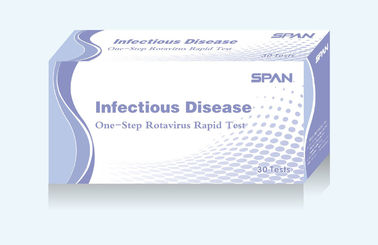|
|
Rotavirus Cassette Rapid Test (Feces)
|
Product Details:
Payment & Shipping Terms:
|
| Package: | 30 Tests/box | Specificity: | 100% |
|---|---|---|---|
| Sensitivity: | 100% |
Rotavirus Rapid Test (Feces)
Cat. No.: RO218I
![]()
INTENDED USE
The Rotavirus Rapid Test Device (Feces) is a rapid visual immunoassay for the qualitative presumptive detection of rotavirus in human fecal specimens. This kit is intended to be used as an aid in the diagnosis of rotavirus infection.
INTRODUCTION
Rotavirus is the most common agent responsible for acute gastroenteritis, mainly in young children. Its discovery in 1973 and its association with infantile gastro-enteritis represented a very important advancement in the study of gastro-enteritis not caused by acute bacterial infection. The rotavirus may still be found while diarrhoea continues. Rotaviral gastroenteritis may result in mortality for populations at risk such as infants, the elderly, and immunocompromised patients. In temperate climates, rotavirus infections occur mainly in the winter months. Endemics as well as epidemics affecting some thousand people have been reported. With hospitalised children suffering from acute entric disease up to 50% of the analysed specimen were positive for rotavirus. The viruses replicate in the cell nucleus and tend to be host species specific producing a characteristic cytopathic effect (CPE). Because rotavirus is extremely difficult to culture, it is unusual to use isolation of the virus in diagnosing an infection. Instead, a variety of techniques have been developed to detect rotavirus in feces.
PRINCIPLE
The Rotavirus Rapid Test Device (Feces) has been designed to detect rotavirus through visual interpretation of color development in the internal strip. The membrane was immobilized with anti-rotavirus antibodies on the test region. During the test, the specimen is allowed to react with colored anti-rotavirus antibodies colloidal gold conjugates, which were precoated on the sample pad of the test. The mixture then moves on the membrane by a capillary action, and interact with reagents on the membrane. If there were enough rotavirus in specimens, a colored band will form at the T region of the membrane. Presence of colored band indicates a positive result, while its absence indicates a negative result. Appearance of a colored band at the control region serves as a procedural control. This indicates that proper volume of specimen has been added and membrane wicking has occurred.
KIT COMPONENTS
| Individually packed test devices | Each device contains a strip with colored conjugates and reactive reagents pre-spreaded at the corresponding regions. |
| Specimens collection cards | For specimens collection use. |
| Specimens dilution tube with buffer | Each contains 2 ml of 0.1 M Phosphate buffered saline (PBS) and 0.02% sodium azide. |
| Disposable pipettes | For watery specimens collection use. |
| Package insert | For operation instruction. |
MATERIALS REQUIRED BUT NOT PROVIDED
| Timer | For timing use. |
| Centrifuge | For treatment of special specimens. |
PRECAUTIONS
1. For professional in vitro diagnostic use only.
2.Do not use after expiration date indicated on the package. Do not use the test if its foil pouch is damaged. Do not reuse tests.
3.This kit contains products of animal origin. Certified knowledge of the origin and/or sanitary state of the animals does not totally
guarantee the absence of transmissible pathogenic agents. It is therefore, recommended that these products be treated as potentially infectious, and handled observing the usual safety precautions (do not ingest or inhale).
4.Avoid cross-contamination of specimens by using a new specimen collection container for each specimen obtained.
5.Read the entire procedure carefully prior to performing any tests.
6.Do not eat, drink or smoke in the area where the specimens and kits are handled. Handle all specimens as if they contain infectious agents. Observe established precautions against microbiological hazards throughout the procedure and follow the standard procedures for proper disposal of specimens. Wear protective clothing such as laboratory coats, disposable gloves and eye protection when specimens are assayed.
7.Buffered Saline contains sodium azide which may react with lead or copper plumbing to form potentially explosive metal azides. When disposing of buffered saline or extracted samples, always flush with copious quantities of water to prevent azide build up.
8.Do not interchange or mix reagents from different lots.
9.Humidity and temperature can adversely affect results.
10.The used testing materials should be discarded in accordance with local, state and/or federal regulations.
STORAGE AND STABILITY
1.The kit should be stored at 2-30°C until the expiry date printed on the sealed pouch.
2.The test must remain in the sealed pouch until use.
3.Do not freeze.
4.Cares should be taken to protect components in this kit from contamination. Do not use if there is evidence of microbial contamination or precipitation. Biological contamination of dispensing equipments, containers or reagents can lead to false results.
SPECIMEN COLLECTION AND STORAGE
1.The Rotavirus Rapid Test Device (Feces) is intended only for use with human fecal specimens.
2.Viral detection is improved by collecting the specimens at the onset of the symptoms. It has been reported that the maximum excretion of rotavirus in the feces of patients with gastroenteritis occurs 3-5 days after onset of symptoms. If the specimens are collected long after the onset of diarrheic symptoms, the quantity of antigen may not be sufficient to obtain a positive reaction or the antigens detected may not be linked to the diarrheic episode.
3.Perform the testing immediately after the specimen collection. Do not leave the specimens at room temperature for prolonged periods. Specimens may be stored at 2-8°C for up to 72 hours.
4.Bring specimens to room temperature prior to testing.
5.Pack the specimens in compliance with applicable regulations for transportation of etiological agents, in case they need to be shipped.
PROCEDURE
Bring tests, specimens, buffer and/or controls to room temperature (15-30°C) before use.
- Specimen collection and pre-treatment:
- Use the specimens collection cards provided in the kit for specimens collection. Follow the operation procedure written on it for instructions. Other clean dry containers could also be used for the same purpose. Best results will be obtained if the assay is performed within 6 hours after collection.
- Unscrew and remove the dilution tube applicator. Be careful not to spill or spatter solution from the tube. Collect specimens by inserting the applicator stick into at least 3 different sites of the feces to collect approximately 50 mg of feces (equivalent to 1/4 of a pea).
- Place the applicator back into the tube and screw the cap tightly. Be careful not to break the tip of the dilution tube.
- Shake the specimen collection tube vigorously to mix the specimen and the extraction buffer. Specimens prepared in the specimen collection tube may be stored for 6 months at -20°C if not tested within 1 hour after preparation.
- Testing
- Remove the test from its sealed pouch, and place it on a clean, level surface. Label the test with patient or control identification. To obtain a best result, the assay should be performed within one hour.
- Using a piece of tissue paper, break the tip of the dilution tube. Hold the tube vertically and dispense 2 drops of solution into the specimen well (S) of the test device.
Avoid trapping air bubbles in the specimen well (S), and do not drop any solution in observation window.
As the test begins to work, you will see color move across the membrane.
- Wait for the colored band to appear. The result should be read at 10 minutes. Do not interpret the result after 20 minutes.
Note: If the specimen does not migrate (presence of particles), centrifuge the extracted specimens contained in the extraction buffer vial. Collect 80 µL of supernatant, dispense into the specimen well (S) of a new test device and start afresh following the instructions mentioned above.
INTERPRETATION OF RESULTS
![]()
POSITIVE:A colored band appears in the control band region (C) and another colored band appears in the A line region.
![]()
NEGATIVE: One colored band appears in the control band region (C). No band appears in the test band region (T).
![]() INVALID RESULT:Control band fails to appear. Results from any test which has not produced a control band at the specified reading time must be discarded. Please review the procedure and repeat with a new test. If the problem persists, discontinue using the kit immediately and contact your local distributor.
INVALID RESULT:Control band fails to appear. Results from any test which has not produced a control band at the specified reading time must be discarded. Please review the procedure and repeat with a new test. If the problem persists, discontinue using the kit immediately and contact your local distributor.
NOTE:
1.The intensity of the color in test region (T) may vary depending on the concentration of aimed substances present in the specimen. Therefore, any shade of color in the test region should be considered positive. Besides, the substances level can not be determined by this qualitative test.
2.Insufficient specimen volume, incorrect operation procedure, or performing expired tests are the most likely reasons for control band failure.
QUALITY CONTROL
1.Internal procedural controls are included in the test. A colored band appearing in the control region (C) is considered an internal positive procedural control. It confirms sufficient specimen volume and correct procedural technique.
2.External controls are not supplied with this kit. It is recommended that positive and negative controls be tested as a good laboratory practice to confirm the test procedure and to verify proper test performance.
LIMITATIONS OF THE TEST
- The Rotavirus Rapid Test Device (Feces) is for professional in vitro diagnostic use, and should be used for the qualitative detection of rotavirus only.
- As with all diagnostic tests, a definitive clinical diagnosis should not be based on the results of a single test, but should only be made by the physician after all clinical and laboratory findings have been evaluated.
- If the test result is negative and clinical symptoms persist, additional testing using other clinical methods is recommended. A negative result does not at any time preclude the possibility of rotavirus infection with low concentration of virus particles.
PERFORMANCE CHARACTERISTICS
Table: Rotavirus Rapid Test vs. Latex Agglutination
|
RelativeSensitivity: >99.9% (95.6%-99.9%)* Relative Specificity: 99.4% (96.5%-99.9%)* Overall Agreement: 99.6% (97.7%-99.9%)* *95% Confidence Interval |
Rotavirus Rapid Test |
||||
| + | Total | ||||
| Latex Agglutination | + | 224 | 2 | 226 | |
| - | 0 | 156 | 156 | ||
| 224 | 158 | 382 | |||
Specificity:
Cross reactivity with following organisms has been studied at 1.0 x 109 organisms/ml. The following organisms were found negative when tested with the Rotavirus Rapid Test Device (Feces).
| Staphylococcus aureus | Proteus mirabilis | Neisseria gonorrhea |
| Pseudomonas aeruginosa | Acinetobacter spp | Group B Streptococcus |
| Enterococcus faecalis | Salmonella choleraesius | Proteus vulgaris |
| Group C Streptococcus | Gardnerella Vag | Enterococcus faecium |
| Klebsiella pneumoniae | Acinetobacter calcoaceticus | Hemophilus influenzae |
| Branhamella catarrhalis | E.coli | Neisseria meningitidis |
| Candida albicans | Chlamydia trachomatis |
Span Biotech Ltd. is a research based company for rapid tests, with strong support from National Key Laboratory of Technology Projects of 10th and 11th Five-Year Plan and Faculty of Life Sciences of HuBei University. SpanBio also housed a R&D team that is developing gene recombination, cell cultivation and protein purification techniques. SpanBio pays strict attention on rapid tests for human being, animal diseases and food safety detection. It provides a number of customized services to professional distributors and partnering affiliates with excellent quality, competitive prices and super service.
Our mission:
- Always best of all and always pay attention to innovation.
- Special customized service tightly following customers’ requests.
- Integrated excellent quality, competitive prices and super service together.
Span Biotech Ltd.
Tel: +86(755)89589611
WhatsAPP:+8618823462100 (WhatsApp)
Web:www.spanbio.com www.spanbiotech.com
Contact Person: Ms. Anna Lee
Tel: +86-755-89589611
Fax: 86-755-89580096




